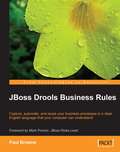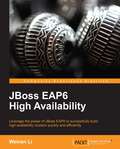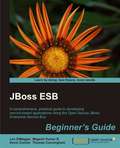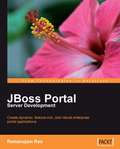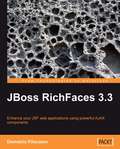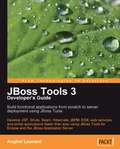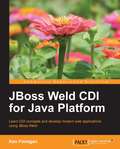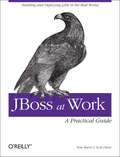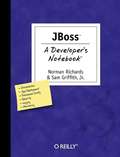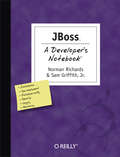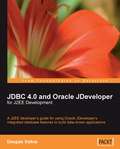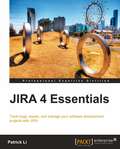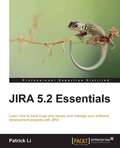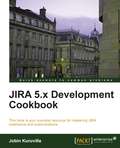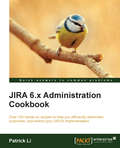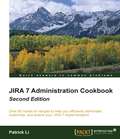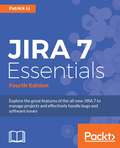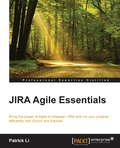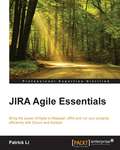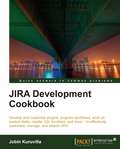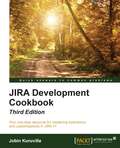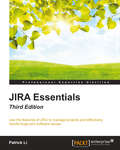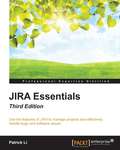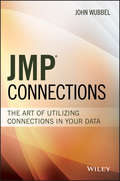- Table View
- List View
JBoss Drools Business Rules
by Paul BrowneThis book takes a practical approach, with step-by-step instructions. It doesn't hesitate to talk about the technologies, but takes time to explain them (to an Excel power-user level). There is a good use of graphics and code where necessary. If you are a business analyst - somebody involved with enterprise IT but at a high level, understanding problems and planning solutions, rather than coding in-depth implementations - then this book is for you. If you are a business user who needs to write rules, or a technical person who needs to support rules, this book is for you. If you are looking for an introduction to rule engine technology, this book will satisfy your needs. If you are a business user and want to write rules using Guvnor/JBoss IDE, this book will be suitable for you. This book will also suit your need if you are a business user and want to understand what Drools can do and how it works, but would rather leave the implementation to a developer.
JBoss EAP6 High Availability
by Weinan LiAn easy-to-follow guide full of hands-on examples of real-world administration tasks.JBoss EAP6 High Availability is ideal for those who want to learn how to use JBoss EAP6 to set up a cluster. Basic knowledge of Linux/Unix is required.
JBoss ESB Beginner’s Guide
by Kevin Conner Len DimaggioPart of Packt's Beginner's Guide series, each chapter contains practical examples with step-by-step instructions and plenty of screenshots to guide you through the implementation of JBoss ESB. This book is intended for Java programmers although you don't need previous experience with middleware such as application servers or ESBs.
JBoss Portal Server Development
by Ramanujam RaoThe book is written from a developer perspective and uses an example-driven approach with extensive code samples on each topic, for easy understanding and learning. It starts with some basic concepts of portals, before going into the features and implementation of JBoss Portal and eventually discussing some concepts for advanced use. Each chapter provides a blend of just enough basic concepts to start building applications and detailed configurations for reference. This book is for portal developers, portal administrators, designers and architects working on the Java platform, who want to build web portal solutions. The book doesn't expect an expert knowledge of portal or JEE technologies, but does presume a basic understanding of web technologies and the Java/JEE platform. However, the concepts are lucid enough that any competent developer can easily find immediate value in the book and start creating dynamic portal applications.
JBoss RichFaces 3.3
by Demetrio FilocamoThis is a practical tutorial following the use of RichFaces in a sample application. It includes many examples of the creation and customization of different AJAX components. This book targets Java Developers who want to enhance their JSF applications by adding AJAX, but without having to use JavaScript. If you want to learn how to use the wide set of AJAX components that you find in the RichFaces framework, this book is for you. You are expected to have basic knowledge of JSF, but no previous experience with AJAX is necessary.
JBoss Tools 3 Developers Guide
by Anghel LeonardSince these technologies covered are different from each other, they are covered in separate chapters that are not interdependent; therefore you can learn to use whichever tool you want, without exploring the previous chapters. This approach sustains the learning per example paradigm and helps you to use the book as a quick guide for your favorite technologies. This book is recommended for Java developers who use at least one of the covered technologies (JSF, Struts, Hibernate, Seam, and so on). It is for all Java developers who are looking for a powerful, unitary tool, especially designed to increase the speed of development and quality of Java web applications. No matter how much (or how little) experience they have, developers of all levels will benefit as their use of JBoss Tools is directly proportional to the complexity of their application. Since JBoss Tools covers all levels of experience, you can use it at your own level for your own applications, without involving unnecessary features. All you need is to be familiar with the Eclipse environment and Java core, and to have some expertise in the technology for which you want to use the JBoss Tools. Basic expertise for each technology is provided in the book, but for more complete and detailed aspects you should read dedicated specifications, tutorials, and articles.
JBoss Weld CDI for Java Platform
by Ken FinneganThis book is a mini tutorial with plenty of code examples and strategies to give you numerous options when building your own applications."JBoss Weld CDI for Java Platform" is written for developers who are new to dependency injection. A rudimentary knowledge of Java is required.
JBoss at Work: A Practical Guide
by Scott Davis Tom MarrsConsisting of a number of well-known open source products, JBoss is more a family of interrelated services than a single monolithic application. But, as with any tool that's as feature-rich as JBoss, there are number of pitfalls and complexities, too.Most developers struggle with the same issues when deploying J2EE applications on JBoss: they have trouble getting the many J2EE and JBoss deployment descriptors to work together; they have difficulty finding out how to get started; their projects don't have a packaging and deployment strategy that grows with the application; or, they find the Class Loaders confusing and don't know how to use them, which can cause problems.JBoss at Work: A Practical Guide helps developers overcome these challenges. As you work through the book, you'll build a project using extensive code examples. You'll delve into all the major facets of J2EE application deployment on JBoss, including JSPs, Servlets, EJBs, JMS, JNDI, web services, JavaMail, JDBC, and Hibernate. With the help of this book, you'll:Implement a full J2EE application and deploy it on JBossDiscover how to use the latest features of JBoss 4 and J2EE 1.4, including J2EE-compliant web servicesMaster J2EE application deployment on JBoss with EARs, WARs, and EJB JARsUnderstand the core J2EE deployment descriptors and how they integrate with JBoss-specific descriptorsBase your security strategy on JAASWritten for Java developers who want to use JBoss on their projects, the book covers the gamut of deploying J2EE technologies on JBoss, providing a brief survey of each subject aimed at the working professional with limited time.If you're one of the legions of developers who have decided to give JBoss a try, then JBoss at Work: A Practical Guide is your next logical purchase. It'll show you in plain language how to use the fastest growing open source tool in the industry today. If you've worked with JBoss before, this book will get you up to speed on JBoss 4, JBoss WS (web services), and Hibernate 3.
JBoss in Action: Configuring the JBoss Application Server
by Peter Johnson Javid JamaeJBoss in Action is the first book to focus on teaching readers in detail how to use the JBoss application server. Unlike other titles about JBoss, the authors of JBoss in Action go deeper into the advanced features and configuration of the server. In particular, it focuses on enterprise-class topics, such as high availability, security, and performance.This book walks readers through the JBoss 5 Application Server from installation to configuration to production development. It shows how to configure the server's various component containers such as the JBoss Web Server, the EJB 3 server, and JBoss Messaging. It also provides detailed insight into configuring the various component services such as security, performance, and clustering. Beyond coverage of the core application server, the book also teaches how to use some of the "hot" technologies that run on top of the application server, such as Jboss Seam and JBoss Portal. Purchase of the print book comes with an offer of a free PDF, ePub, and Kindle eBook from Manning. Also available is all code from the book. The authors, both seasoned professional experts at developing and administering JBoss, provide meaningful explanations and background on many topics which they tie in with their own practical, real-world advice from their collective experience. These uniquely comprehensive explanations and the wide coverage provided in this book surpass any other content currently available in any other book, article, or documentation on the subject.
JBoss: A Developer's Notebook
by Sam Griffith Norman RichardsThere's nothing ordinary about JBoss. What began as an open source EJB container project six years ago has become a fully certified J2EE 1.4 application server with the largest market share, competitive with proprietary Java application servers in features and quality. And with its dynamic architecture, JBoss isn't just a J2EE server. You can alter the services to make J2EE work the way you want, or even throw J2EE away completely. After more than a million downloads, many JBoss users are no longer trying it out on internal test boxes, but rolling it out on production machines. JBoss: A Developer's Notebook takes you on a complete tour of JBoss in a very unique way: rather than long discussions, you will find code--lots of code. In fact, the book is a collection of hands-on labs that take you through the critical JBoss features step-by-step. You don't just read about JBoss, you learn it through direct practical application. That includes exploring the server's many configurations: from bare features for simple applications, to the lightweight J2EE configuration, to everything JBoss has in store-including Hibernate and Tomcat. JBoss: A Developer's Notebook also introduces the management console, the web services messaging features, enhanced monitoring capabilities, and shows you how to improve performance. At the end of each lab, you'll find a section called "What about..." that anticipates and answers likely follow-up questions, along with a section that points you to articles and other resources if you need more information. JBoss is truly an extraordinary application server. And we have an extraordinary way for you to learn it.
JBoss: A Developer's Notebook
by Sam Griffith Norman RichardsThere's nothing ordinary about JBoss. What began as an open source EJB container project six years ago has become a fully certified J2EE 1.4 application server with the largest market share, competitive with proprietary Java application servers in features and quality. And with its dynamic architecture, JBoss isn't just a J2EE server. You can alter the services to make J2EE work the way you want, or even throw J2EE away completely. After more than a million downloads, many JBoss users are no longer trying it out on internal test boxes, but rolling it out on production machines. JBoss: A Developer's Notebook takes you on a complete tour of JBoss in a very unique way: rather than long discussions, you will find code--lots of code. In fact, the book is a collection of hands-on labs that take you through the critical JBoss features step-by-step. You don't just read about JBoss, you learn it through direct practical application. That includes exploring the server's many configurations: from bare features for simple applications, to the lightweight J2EE configuration, to everything JBoss has in store-including Hibernate and Tomcat. JBoss: A Developer's Notebook also introduces the management console, the web services messaging features, enhanced monitoring capabilities, and shows you how to improve performance. At the end of each lab, you'll find a section called "What about..." that anticipates and answers likely follow-up questions, along with a section that points you to articles and other resources if you need more information. JBoss is truly an extraordinary application server. And we have an extraordinary way for you to learn it.
JDBC 4.0 and Oracle JDeveloper for J2EE Development
by Deepak VohraBeing a quick reference guide, this book has a focused approach. You will learn to develop J2EE applications with JDBC and JDeveloper in no time. The book covers lot of practical examples, which makes it developer-friendly learning material. The book is suitable for Java/J2EE and Oracle JDeveloper beginners. If you are a J2EE developer and want to use the JDeveloper IDE for J2EE development, this book is for you. JDeveloper developers who are new to J2EE will also benefit from the book. Most J2EE applications have a database component and the book is specially suited for database-based J2EE development in Oracle JDeveloper. You can also use this book if you are interested in learning how to utilize the new features offered in JDBC 4.0 for Java/J2EE development.
JIRA 4 Essentials
by Patrick LiThis book is a step-by-step tutorial and is packed with practical examples that will make learning JIRA easy.If you want to get started with JIRA, then this is the perfect book for you. You will need to be familiar with basic computer knowledge for your or your organization's standard operating environment and to have experience with software project management.
JIRA 5.2 Essentials
by Patrick LiJIRA 5.2 Essentials is packed with real-world examples and practical tutorials which will help you become a JIRA expert.If you want to get started with JIRA, then this book is made for you. Only basic computer skills and project or issue management knowledge is required. The book will provide the rest. This book would also be of interest to experienced JIRA users who wish to improve their workflow and master the new features of JIRA 5.2.
JIRA 5.x Development Cookbook
by Jobin KuruvillaJIRA 5.x Development Cookbook is part of Packt's Cookbook series. A Packt Cookbook contains step-by-step recipes for solutions to the most important problems you face when working with a topic.Inside this Cookbook you will find:A straightforward and easy-to-follow format.A selection of the most important tasks and problems.Carefully organized instructions for solving the problem efficiently.Clear explanations of what you did.Details for applying the solution to other situations.If you are a JIRA developer or project manager who wants to fully exploit the exciting capabilities of JIRA, then this is the perfect book for you.
JIRA 6.x Administration Cookbook
by Patrick LiA comprehensive guide, full of practical recipes with real-life JIRA administration challenges, solutions, and examples with illustrations from the actual application. If you are an administrator who will be customizing, supporting, and maintaining JIRA for your organization, this book is for you. Familiarity with the core concepts of JIRA is essential. For some recipes, basic understanding in HTML, CSS, and JavaScript will also be helpful.
JIRA 7 Administration Cookbook - Second Edition
by Patrick LiOver 80 hands-on recipes to help you efficiently administer, customize, and extend your JIRA 7 implementation About This Book * Make JIRA adapt to your organization and process flow * Gather and display the right information from users with customized forms and layouts * Extend the capabilities of JIRA with add-ons, scripts, and integrations with other popular applications and cloud platforms * Use JIRA Service Desk as a customer service support portal Who This Book Is For This book is for administrators who customize, support, and maintain JIRA for their organization. What You Will Learn * Customize basic settings for your projects, such as screens and fields * Create and customize workflows to suit your business process needs * Make workflows more effective and efficient * Manage users and groups inside JIRA and manage advanced login options * Secure your JIRA instance using effective practices * Perform e-mail functionalities with JIRA * Extend JIRA to integrate with other products and services In Detail JIRA 7 Administration Cookbook, Second Edition covers all the new major features that provide better prioritizing capabilities, enhanced visibility, and the ability to customize JIRA application to meet your needs. We start by upgrading your existing JIRA instance and working through tasks you can perform at the server level to better maintain it. We then delve deep into adapting JIRA to your organization's needs, starting with the visual elements of setting up custom forms to capturing important data with custom fields and screens, and moving on to ensuring data integrity through defining field behaviors. You'll gain insights into JIRA's e-mail capabilities, including managing outgoing e-mail rules and processing incoming e-mails for automated issue creation. The book contains tips and tricks that will make things easier for you as administrators, such as running scripts to automate tasks, getting easy access to logs, and working with tools to troubleshoot problems. The book concludes with a chapter on JIRA Service Desk, which will enable you to set up and customize your own support portal, work with internal teams to solve problems, and achieve optimized services with SLA. Style and approach This recipe-based book allows administrators to explore the exciting capabilities of JIRA. After reading this book, you will be able to extend and customize your JIRA implementation.
JIRA 7 Essentials - Fourth Edition
by Patrick LiExplore the great features of the all-new JIRA 7 to manage projects and effectively handle bugs and software issues About This Book * Updated for JIRA 7, this book covers all the new features introduced in JIRA 7 with a dedicated chapter on JIRA Service Desk--one of the biggest new add-ons to JIRA * This book lays a strong foundation to work with agile projects in JIRA from both the administrator and end user's perspective * Work through step-by-step exercises at the end of each chapter for you to try out and reinforce your skills Who This Book Is For This book will be especially useful for project managers but it's also intended for other JIRA users, including developers, and any other industry besides software development, who would like to leverage JIRA's powerful task management and workflow features to better manage their business processes. What You Will Learn * Understand JIRA's data hierarchy and how to design and work with projects in JIRA * Plan and set up a new JIRA 7 instance from scratch for production use * Using JIRA for agile software projects, business process management, customer service support, and more * Understand issues and work with them * Design both system and custom fields to behave differently under different contexts * Create and design your own screens and apply them to different project and issue types * Gain an understanding of the workflow and its various components * Set up both incoming and outgoing mail servers to work with e-mails In Detail Atlassian JIRA is an enterprise-issue tracker system. One of its key strengths is its ability to adapt to the needs of the organization, ranging from building Atlassian application interfaces to providing a platform for add-ons to extend JIRA's capabilities. JIRA 7 Essentials, now in its fourth edition, provides a comprehensive explanation covering all major components of JIRA 7, which includes JIRA Software, JIRA Core, and JIRA Service Works. The book starts by explaining how to plan and set up a new JIRA 7 instance from scratch for production use before moving on to the more key features such as e-mails, workflows, business processes, and so on. Then you will understand JIRA's data hierarchy and how to design and work with projects in JIRA. Issues being the corner stone of using JIRA, you will gain a deep understanding of issues and their purpose. Then you will be introduced to fields and how to use custom fields for more effective data collections. You will then learn to create new screens from scratch and customize it to suit your needs. The book then covers workflows and business processes, and you will also be able to set up both incoming and outgoing mail servers to work with e-mails. Towards the end, we explain JIRA's security model and introduce you to one of JIRA's new add-ons: JIRA Service Desk, which allows you to run JIRA as a computer support portal. Style and approach This is a comprehensive, practical guide on using JIRA to efficiently manage all your projects. It provides clear, step-by-step explanations, and shows how you can use the various features of JIRA to manage your projects more efficiently.
JIRA Agile Essentials
by Patrick LiIf you want to get started with JIRA Agile and learn how to run your JIRA projects the agile way, then this is the perfect book for you. You will need to be familiar with the basics of JIRA, both from an end user's and an administrator's perspective. Experience with workflows, custom fields, and other administrative functions of JIRA will be useful.
JIRA Agile Essentials
by Patrick Li<P><P>Bring the power of Agile to Atlassian JIRA and run your projects efficiently with Scrum and Kanban <P><P>About This Book <P><P>Plan and manage projects effortlessly with JIRA Agile by integrating it with other applications <P><P>Improve your team's performance with Scrum and Kanban together with agile methodology <P><P>Easy-to-follow learning guide to install JIRA Agile and understand how it fits in with Atlassian JIRA <P><P>Who This Book Is For <P><P>If you want to get started with JIRA Agile and learn how to run your JIRA projects the agile way, then this is the perfect book for you. You will need to be familiar with the basics of JIRA, both from an end user's and an administrator's perspective. Experience with workflows, custom fields, and other administrative functions of JIRA will be useful. <P><P>What You Will Learn <P><P>Understand how JIRA Agile and JIRA work together <P><P>Install JIRA Agile and extend it beyond project tracking <P><P>Manage and run your JIRA projects with Scrum or Kanban <P><P>Customize your agile boards to adapt to your team's workflow process <P><P>Create and share project statuses with amazing charts <P><P>Plan your sprints with JIRA Agile and Team Calendar <P><P>Integrate JIRA Agile with Confluence <P><P>Redefine your project management process with the Atlassian stack <P><P>In Detail <P><P>JIRA Agile (formerly known as GreenHopper) is a plugin that adds agile project management to any JIRA project. It allows you to visualize your existing process and stimulate incremental improvement. JIRA Agile brings the power of agile methodology to Atlassian JIRA. <P><P>With JIRA Agile Essentials you will dive straight into the action, exploring critical agile terminologies and concepts in the context of JIRA Agile. Learn to install and run JIRA Agile, and set it up to run with Scrum and Kanban. Collaborate with your colleagues to define requirements, create user stories, and manage and plan sprints based on the availability of your members. Create reports and share your project progress with other stakeholders. <P><P>With this practical guide, you will develop a great working knowledge of JIRA Agile and make your project management much more efficient.
JIRA Development Cookbook
by Jobin KuruvillaThis book is part of Packt's Cookbook series. A Packt Cookbook contains step-by-step recipes for solutions to the most important problems you face when working with a topic. Inside this Cookbook you will find: A straightforward and easy-to-follow format, A selection of the most important tasks and problems ,Carefully organized instructions for solving the problem efficiently, Clear explanations of what you did Details for applying the solution to other situations If you are a JIRA developer or project manager who wants to fully exploit the exciting capabilities of JIRA, then this is the perfect book for you.
JIRA Development Cookbook - Third Edition
by Jobin KuruvillaYour one-stop resource for mastering extensions and customizations in JIRA 7+ About This Book * Explore the new features of JIRA 7 and best practices for agile development and integration with development tools * Customize the look and feel of your JIRA UI to match your specific user needs * Create seamless reports that make sense of your data through easy-to-use techniques Who This Book Is For If you are a JIRA developer or administrator, or a project manager who wants to fully exploit the exciting capabilities of JIRA, then this is the perfect book for you. What You Will Learn * Create and deploy your own JIRA plugins * Manipulate workflows to transform JIRA into a user-friendly system * Create custom reports that show statistics for particular people, projects, versions, or other fields within issues * Simplify reporting by writing your own JIRA gadgets, which can be added into a user's dashboard * Master database handling by extending and retrieving custom field details from the database * Deal with custom fields on an issue and program custom field option In Detail JIRA provides issue and project tracking for software development teams to improve code quality and the speed of development. With the new version of JIRA, you can create your own JIRA plugins and customize the look and feel of your JIRA UI easier than ever. JIRA Development Cookbook , Third Edition, is a one-stop resource to master extensions and customizations in JIRA. This book starts with recipes about simplifying the plugin development process followed by recipes dedicated to the plugin framework. Then, you will move on to writing custom field plugins to create new field types or custom searchers. You will also learn how to program and customize workflows to transform JIRA into a user-friendly system. With so much data spanning different projects, issues, and so on, we will cover how to work on reports and gadgets to get customized data according to our needs. At the end of the book, you will learn how to customize JIRA by adding new tabs, menus, and web items; communicate with JIRA via the REST APIs; and work with the JIRA database. Style and approach The most unique aspect of this book is its approach. This book is recipe-based, with real-world examples, that will empower you to implement agile processes and explore the exciting capabilities of Jira.
JIRA Essentials - Third Edition
by Patrick LiIf you wish to develop your practical skills with JIRA in order to install, use, and manage your projects, then this is the perfect book for you. You need to be familiar with software project management and basic computer operations, specifically the system on which you will use JIRA.
JIRA Essentials Third Edition
by Patrick Li<P><P>Use the features of JIRA to manage projects and effectively handle bugs and software issues <P><P>About This Book <P><P>Install, build, and implement your own Atlassian JIRA instance to track and manage projects <P><P>Customize your JIRA with data capture and display, workflow design, and security to suit your requirements <P><P>Step-by-step exercises at the end of each chapter for you to try out and reinforce your skills <P><P>Who This Book Is For <P><P>If you wish to develop your practical skills with JIRA in order to install, use, and manage your projects, then this is the perfect book for you. You need to be familiar with software project management and basic computer operations, specifically the system on which you will use JIRA. <P><P>What You Will Learn <P><P>Learn about the JIRA architecture and essential components that help you prepare for deployments <P><P>Understand JIRA from both an end users and administrator's perspective <P><P>Design and implement custom forms to capture information with custom fields, screens, and validation rules <P><P>Create and design custom workflows with complex validation logic and business rules <P><P>Secure JIRA data from unauthorized access <P><P>Notify users with updates using automated e-mail rules <P><P>Search, report on, and analyze your project progress <P><P>Manage and run projects with Agile methodologies <P><P>In Detail <P><P>Atlassian JIRA is an enterprise issue tracker system. One of its key strengths is its ability to adapt to the needs of the organization, ranging from building Atlassian application interfaces to providing a platform for add-ons to extend JIRA's capabilities. <P><P>JIRA Essentials, Third Edition provides a comprehensive explanation covering all major features of Atlassian JIRA, broken down and organized in logical order. The book starts by showing you how to set up your own JIRA instance before introducing you to key features and concepts such as business processes, workflows, e-mails, and notifications. This book will show you how to develop software more efficiently by planning, designing, and customizing your own JIRA implementation. At the end of each chapter, you will have the opportunity to put your newly acquired knowledge into practice by following a step-by-step, hands-on project that you will build throughout the book.
JMP Connections: The Art of Utilizing Connections In Your Data
by John WubbelAchieve best-in-class metrics and get more from your data with JMP JMP Connections is the small- and medium-sized business owner's guide to exceeding customer expectations by getting more out of your data using JMP. Uniquely bifunctional, this book is divided into two parts: the first half of the book shows you what JMP can do for you. You'll discover how to wring every last drop of insight out of your data, and let JMP parse reams of raw numbers into actionable insight that leads to better strategic decisions. You'll also discover why it works so well; clear explanations break down the Connectivity platform and metrics in business terms to demystify data analysis and JMP while giving you a macro view of the benefits that come from optimal implementation. The second half of the book is for your technical team, demonstrating how to implement specific solutions relating to data set development and data virtualization. In the end, your organization reduces Full Time Equivalents while increasing productivity and competitiveness. JMP is a powerful tool for business, but many organizations aren't even scratching the surface of what their data can do for them. This book provides the information and technical guidance your business needs to achieve more. Learn what a JMP Connectivity Platform can do for your business Understand Metrics-on-Demand, Real-Time Metrics, and their implementation Delve into technical implementation with information on configuration and management, version control, data visualization, and more Make better business decisions by getting more and better information from your data Business leadership relies on good information to make good business decisions—but what if you could increase the quality of the information you receive, while getting more of what you want to know and less of what you don't need to know? How would that affect strategy, operations, customer experience, and other critical areas? JMP can help with that, and JMP Connections provides real, actionable guidance on getting more out of JMP.
